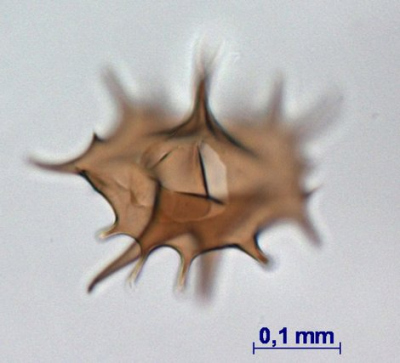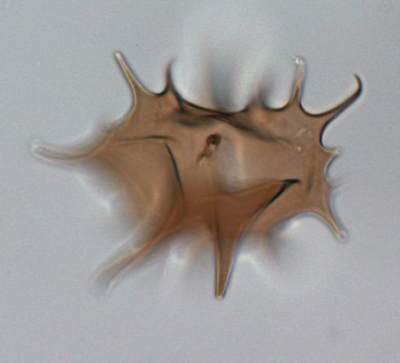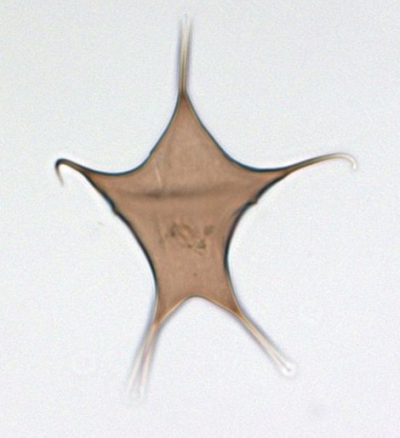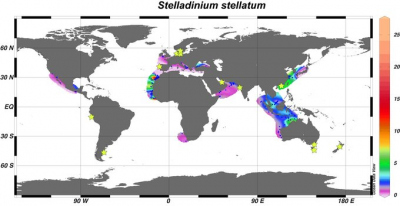Die Inhalte dieser Seite sind leider nicht auf Deutsch verfügbar.
Seitenpfad:
- Modern Dinocyst Key
- brown cysts
- cysts with peridinioid form
- Peridinioid cysts with spines-processes
- Stelladinium stellatum
Stelladinium stellatum
Zonneveld, K.A.F. and Pospelova V. (2015). A determination key for modern dinoflagellate cysts. Palynology 39 (3), 387- 407.



apical/dorsal view
single grain WRC
sample GeoB 154xx, Adriatic Sea
photograph by Karin Zonneveld
single grain WRC
sample GeoB 154xx, Adriatic Sea
photograph by Karin Zonneveld
antapical/ventral view
SG-WRC
sample GeoB 154xx, Adriatic Sea
photograph by Karin Zonneveld
SG-WRC
sample GeoB 154xx, Adriatic Sea
photograph by Karin Zonneveld
cross section
SG-WRC
sample GeoB 154xx, Adriatic Sea
photograph by Karin Zonneveld
SG-WRC
sample GeoB 154xx, Adriatic Sea
photograph by Karin Zonneveld
Field characteristics
Stelladinium stellatum (Wall) Reid 1977
Characteristics:
Proximate cyst with a pentagonal body, often compressed dorso-ventrally, and five distinct horns positioned at each of the angles of the cyst body. The episome is smaller than the hyposome, and the autophragm is thin, with a smooth to scabrate surface. Supplementary horns can be present around the cingular zone. Archeopyle, when observed, is large, and intercalary (2a’).
Motile affinity: Protoperidinium compressum (Abé) Balech
Cyst theca relationship: Wall and Dale, 1968
Dimensions: Cyst body (with horns): 35 to 103 (width) x 60 to 104 (length) µm.
Comparison with other species:
The differentiating characteristics of this species from other dorso-ventrally compressed pentagonal cysts is that the walls of the processes connect way before it reaches the distal end of the processes. It differs from S. robusum by the smaller size and the presence of processes in the cingular region.
Characteristics:
Proximate cyst with a pentagonal body, often compressed dorso-ventrally, and five distinct horns positioned at each of the angles of the cyst body. The episome is smaller than the hyposome, and the autophragm is thin, with a smooth to scabrate surface. Supplementary horns can be present around the cingular zone. Archeopyle, when observed, is large, and intercalary (2a’).
Motile affinity: Protoperidinium compressum (Abé) Balech
Cyst theca relationship: Wall and Dale, 1968
Dimensions: Cyst body (with horns): 35 to 103 (width) x 60 to 104 (length) µm.
Comparison with other species:
The differentiating characteristics of this species from other dorso-ventrally compressed pentagonal cysts is that the walls of the processes connect way before it reaches the distal end of the processes. It differs from S. robusum by the smaller size and the presence of processes in the cingular region.
Geographic distribution
Geographic distribution based on :
Zonneveld et al., 2013. Atlas of modern dinoflagellate cyst distribution based on 2405 datapoints. Review of Palaeobotany and Palynology, v. 191, 1-197
Zonneveld et al., 2013. Atlas of modern dinoflagellate cyst distribution based on 2405 datapoints. Review of Palaeobotany and Palynology, v. 191, 1-197
Stelladinium stellatum is a temperate/subtropical to equatorial coastal species. Relative abundances can be high in regions with hypersaline conditions as well as areas where salinities are reduced (such as in river plumes). Highest relative abundances occur in mesotrophic to eutrophic environments such as upwelling areas. It is not reported from oxygen minimum zones or where bottom waters are anoxic.

Distribution:
Stelladinium stellatum is restricted to coastal sites from temperate/sub-tropical to equatorial regions although it is most abundant in sub-tropical to equatorial regions. Highest abundances (up to 26%) occur in the upwelling area off NW Africa.
Environmental parameter range:
SST: 8.1 - 29.8°C (winter - spring), SSS: 17.8 - 38.9 (winter - summer), [P]: 0.06 - 1.06 μmol/l, [N]: 0.2 - 6.3 μmol/l, chlorophyll-a: 0.1 - 12.2 ml/l, bottom waters [O2]: 0.6 - 5.8 ml/l.
High relative abundances occur where SSS are reduced throughout the year (up to 3% of the association) and in hypersaline environments (up to 2.3%) The Highest relative abundances occur however at full-marine sites where (seasonally) mesotrophic to eutrophic conditions occur. This includes upwelling areas, where large inter-annual variability in the trophic state of the upper waters can occur.
Comparison with other records:
Apart from the recordings in this Atlas Stelladinium stellatum has been observed in coastal sediments off southern China (Wang et al., 2004c), off India and Gulf of Oman in the eastern Arabian Sea (Bradford and Wall, 1984; Godhe et al., 2000; D'Costa et al., 2008), the Peruvian upwelling area (Biebow et al., 1993), the upwelling area off the Iberian Peninsula (Sprangers et al., 2004), coastal sediments of the German and Swedish coasts (North Sea, Baltic Sea, Nehring, 1994a, b; Persson et al., 2000a) and coastal sediments of southern Australia, Tasmania and New Zealand (see references in Marret and Zonneveld, 2003).
Sediment trap studies document cyst formation during active upwelling in the upwelling areas off NW Africa and off Somalia (Zonneveld and Brummer, 2000; Zonneveld et al., 2010). In the Omura Bay (Japan) cysts are produced in winter when temperatures are low for the region (ca. 10°C, Fujii and Matsuoka, 2006).
In eutrophication studies in the subtropical and tropical areas, the species can often be linked to anthropogenic pollution and/or hypertrophic conditions (Shin et al., 2010; Zonneveld et al., 2012).
Stelladinium stellatum is restricted to coastal sites from temperate/sub-tropical to equatorial regions although it is most abundant in sub-tropical to equatorial regions. Highest abundances (up to 26%) occur in the upwelling area off NW Africa.
Environmental parameter range:
SST: 8.1 - 29.8°C (winter - spring), SSS: 17.8 - 38.9 (winter - summer), [P]: 0.06 - 1.06 μmol/l, [N]: 0.2 - 6.3 μmol/l, chlorophyll-a: 0.1 - 12.2 ml/l, bottom waters [O2]: 0.6 - 5.8 ml/l.
High relative abundances occur where SSS are reduced throughout the year (up to 3% of the association) and in hypersaline environments (up to 2.3%) The Highest relative abundances occur however at full-marine sites where (seasonally) mesotrophic to eutrophic conditions occur. This includes upwelling areas, where large inter-annual variability in the trophic state of the upper waters can occur.
Comparison with other records:
Apart from the recordings in this Atlas Stelladinium stellatum has been observed in coastal sediments off southern China (Wang et al., 2004c), off India and Gulf of Oman in the eastern Arabian Sea (Bradford and Wall, 1984; Godhe et al., 2000; D'Costa et al., 2008), the Peruvian upwelling area (Biebow et al., 1993), the upwelling area off the Iberian Peninsula (Sprangers et al., 2004), coastal sediments of the German and Swedish coasts (North Sea, Baltic Sea, Nehring, 1994a, b; Persson et al., 2000a) and coastal sediments of southern Australia, Tasmania and New Zealand (see references in Marret and Zonneveld, 2003).
Sediment trap studies document cyst formation during active upwelling in the upwelling areas off NW Africa and off Somalia (Zonneveld and Brummer, 2000; Zonneveld et al., 2010). In the Omura Bay (Japan) cysts are produced in winter when temperatures are low for the region (ca. 10°C, Fujii and Matsuoka, 2006).
In eutrophication studies in the subtropical and tropical areas, the species can often be linked to anthropogenic pollution and/or hypertrophic conditions (Shin et al., 2010; Zonneveld et al., 2012).


